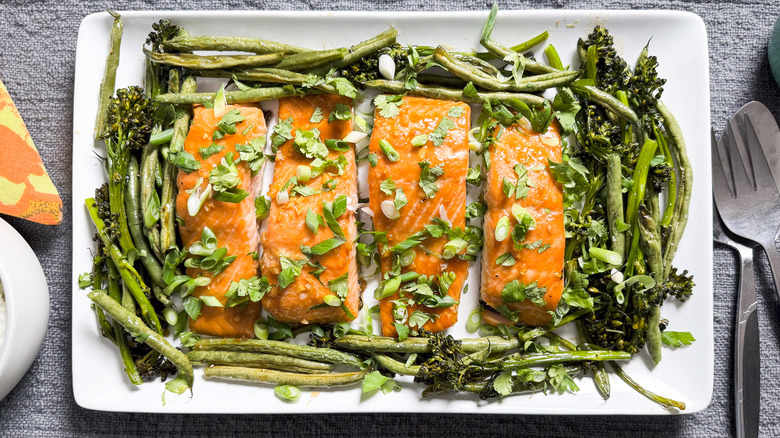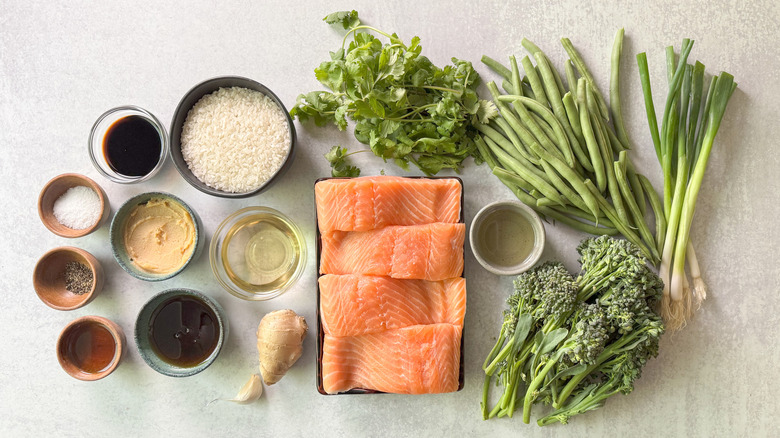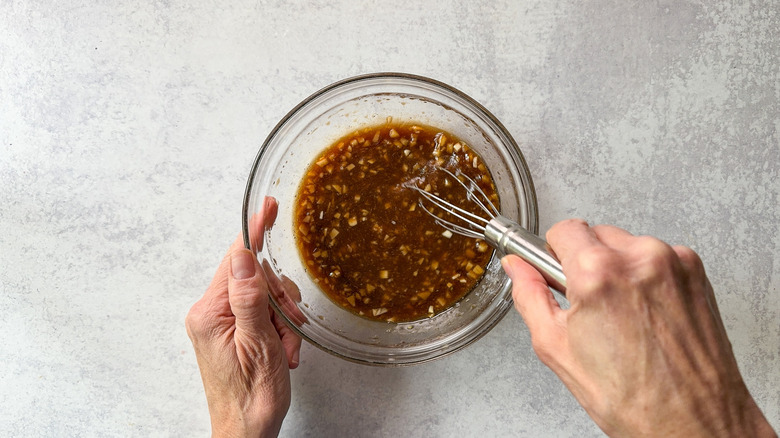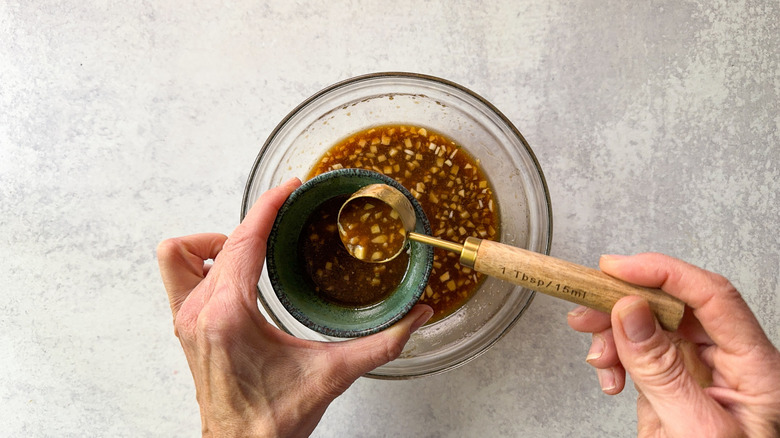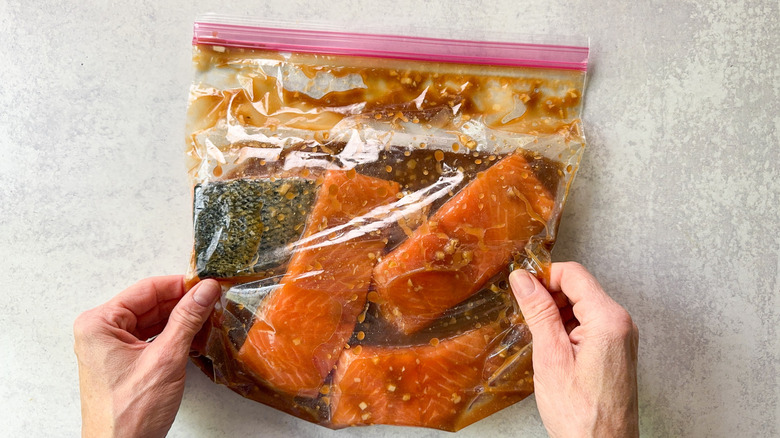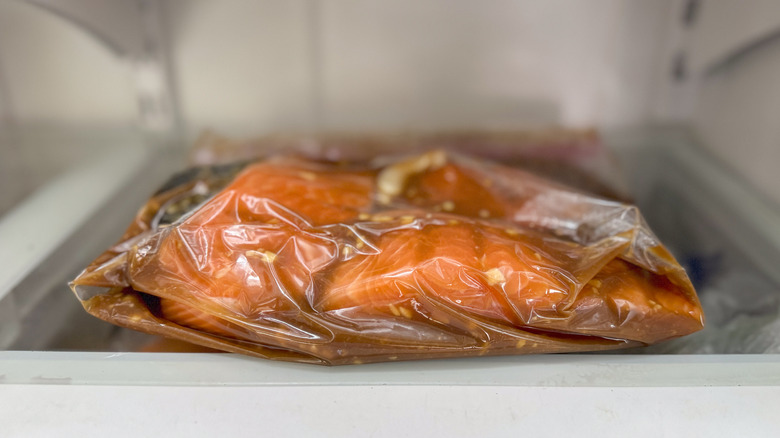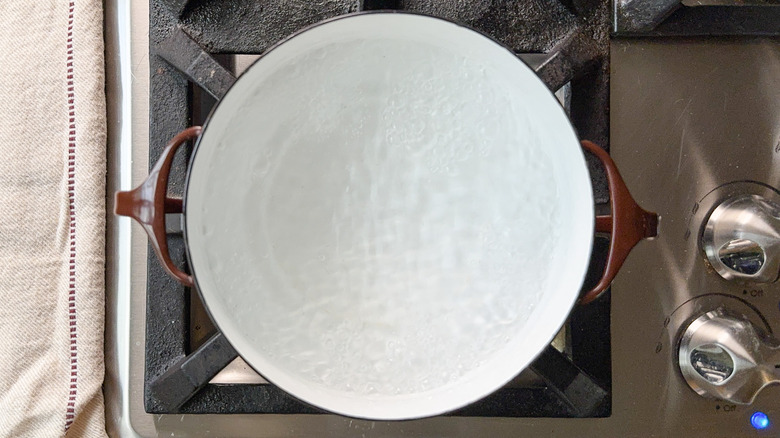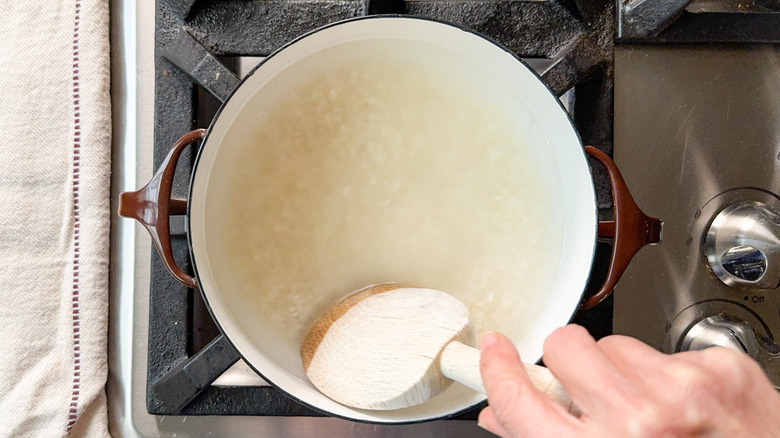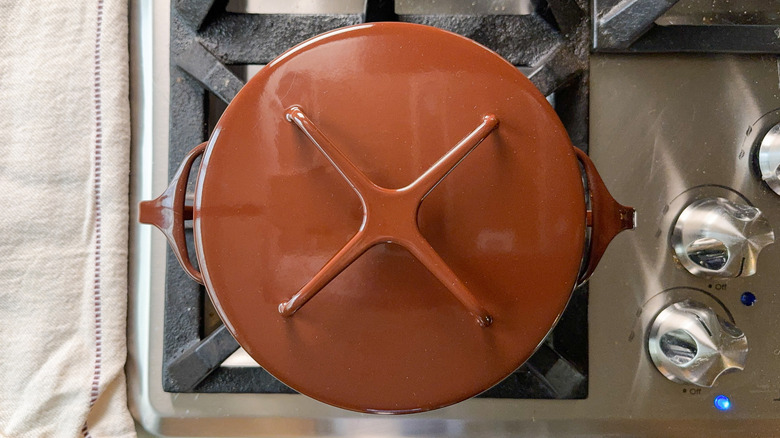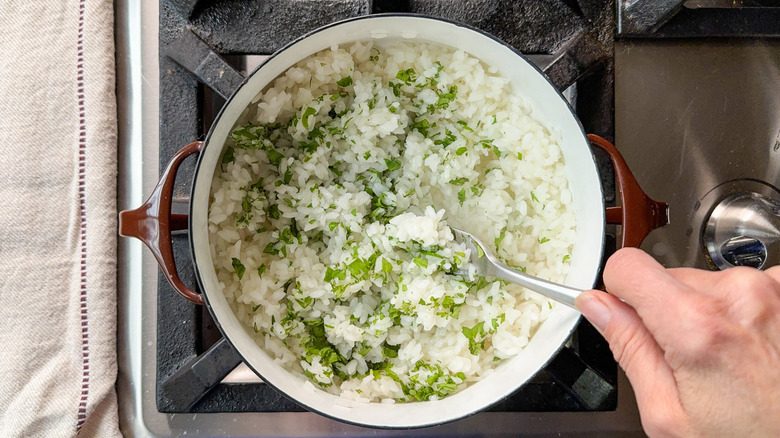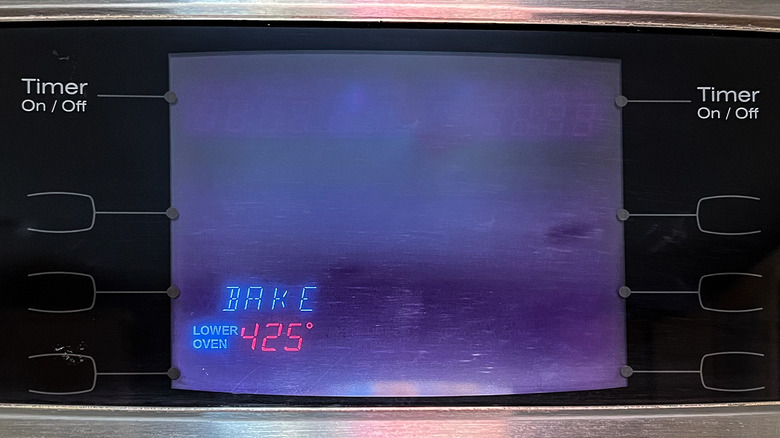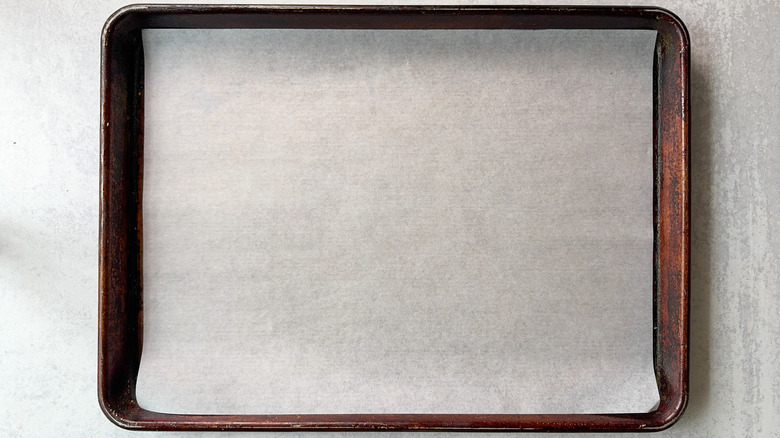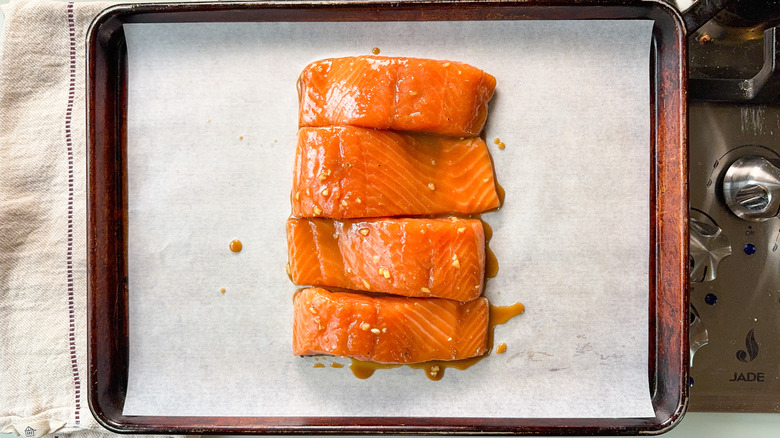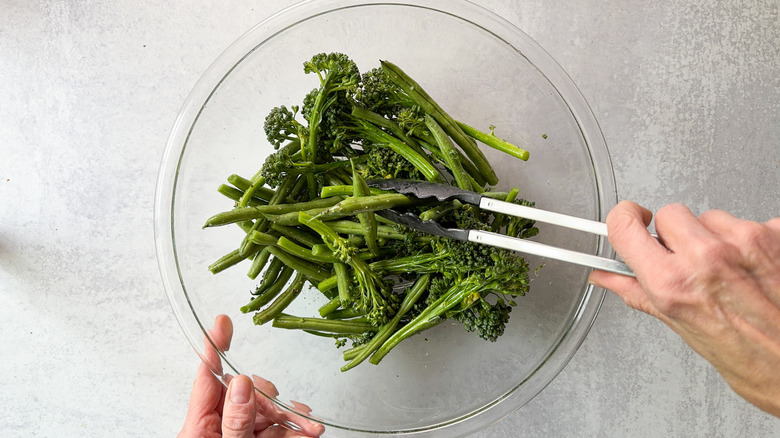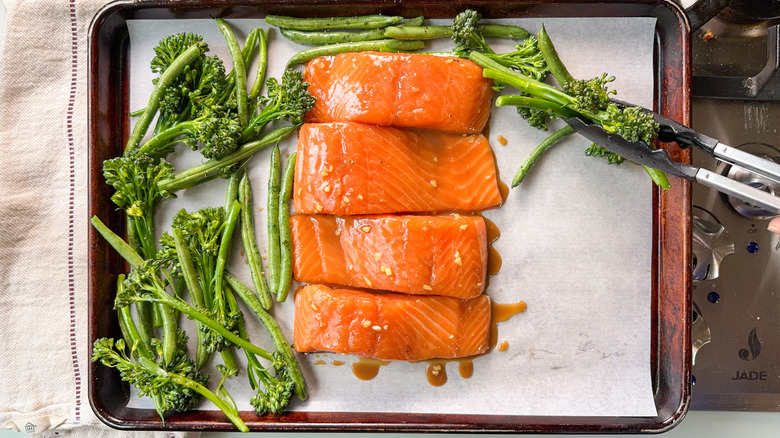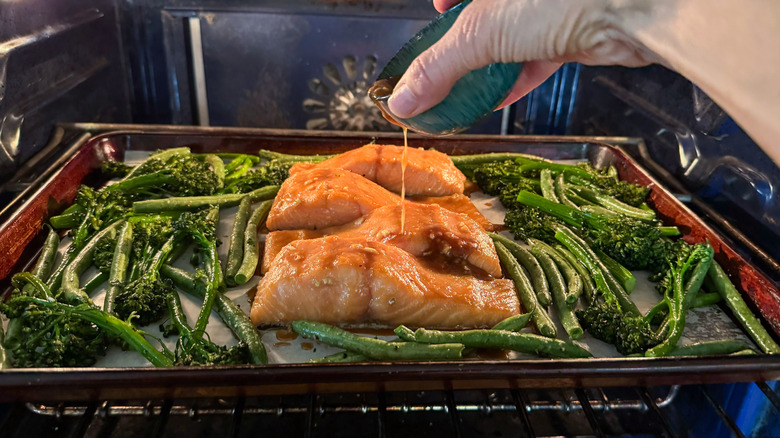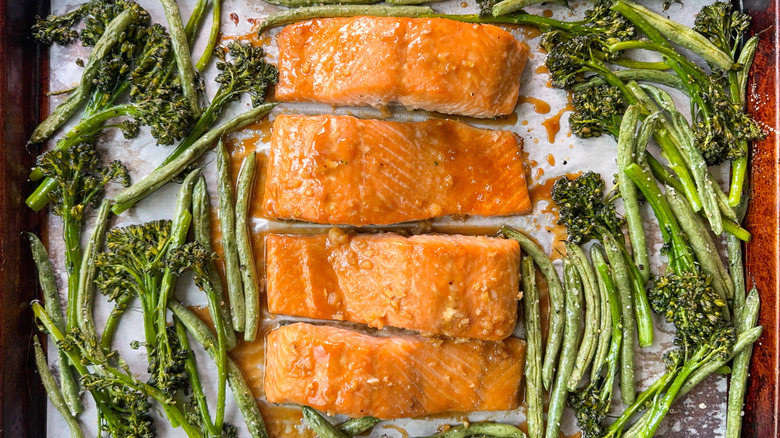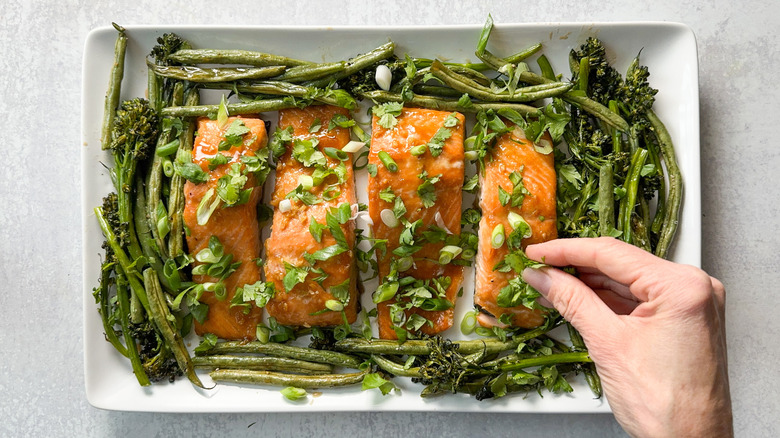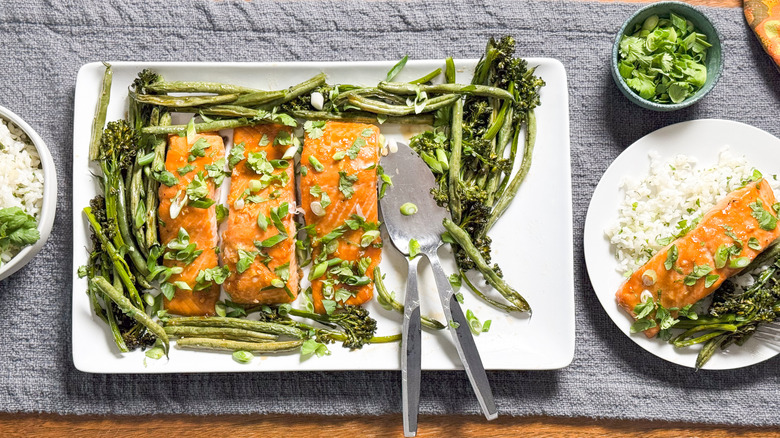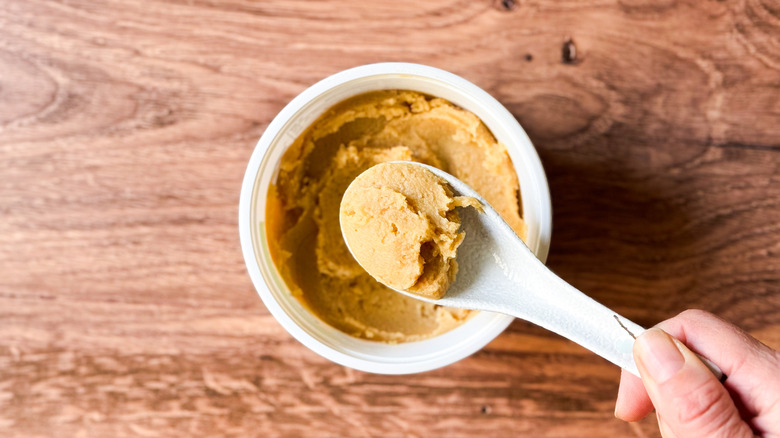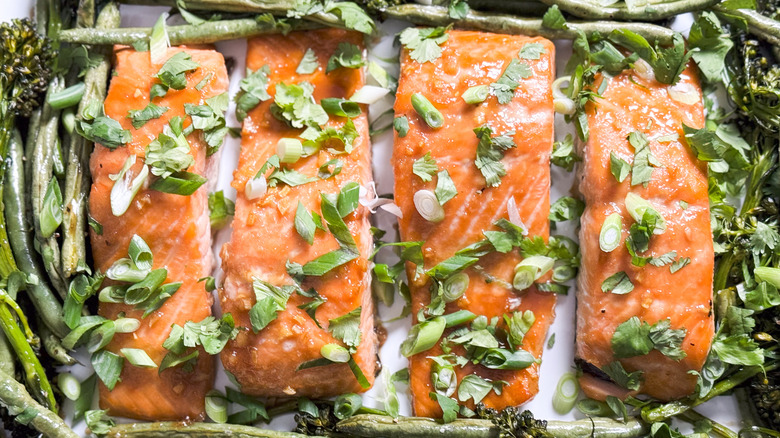Roasted Miso Maple Salmon Recipe
Are you intrigued by the idea of cooking with miso, but not sure where to begin beyond soup? Rich, earthy miso paste can give an umami boost to a variety of savory dishes, yet it also pairs seamlessly with sweet flavors. Miso, which is made from fermented soybeans and grains, adds a refined depth of flavor to any dish and can be found in a range of styles from subtle and slightly sweet to bold and pungent.
This recipe for roasted miso maple salmon — courtesy of recipe developer Julie Kinnaird – elevates humble salmon fillets with a quick and flavorful marinade of white miso, maple syrup, fresh ginger and garlic, mirin, soy, and sesame oil. Maple syrup and miso have the perfect harmonious balance of sweet and salty, which caramelize together in the cooking process. The marinated fillets are roasted with broccolini and green beans for a speedy, yet elegant and eye-catching one-pan dish suitable for any day of the week. Served with quick, easy, and flavorful cilantro rice, this dish is every bit as delicious as it is satisfying and sophisticated.
Gather the roasted miso maple salmon ingredients
To prepare this recipe, start with thick-cut, skin-on salmon fillets. Leaving the skin on helps to keep the fillets intact and seal in moisture while also imparting a bit of fat into the flesh. Make sure you rinse and pat dry your fillets, and avoid a common salmon-cooking mistake by removing any pin bones before cooking. The umami-rich flavor of this recipe comes from a marinade made from white miso paste, maple syrup, mirin, soy sauce, sesame oil, chopped fresh garlic, and ginger root. Part of this marinade is reserved for drizzling on the salmon at the end of the roasting process, which allows it to caramelize on the surface. You will also make cilantro rice from basic white rice, sea salt, and fresh cilantro. Tender broccolini and green beans tossed with a bit of avocado oil are added to a sheet pan with the salmon and everything is roasted together. The dish is finished with sliced scallions and a bit more of the chopped cilantro.
Step 1: Make the miso maple marinade
In a bowl, mix together the miso, maple syrup, mirin, soy sauce, sesame oil, garlic, and ginger.
Step 2: Set aside some marinade
Set aside 2 tablespoons of the miso maple marinade in a small bowl.
Step 3: Marinate the salmon
Place the salmon fillets in a large ziplock bag and add the remaining marinade.
Step 4: Refrigerate the salmon
Refrigerate the salmon for 30 minutes.
Step 5: Boil water for the rice
While the salmon marinates, bring 2 cups water and 1 teaspoon sea salt to a boil.
Step 6: Add the rice
Add the rice, stir, and bring back to a simmer.
Step 7: Cover the rice
Cover and cook for 15 minutes.
Step 8: Fluff the rice and add cilantro
Turn off the heat, fluff the rice, and stir in ¼ cup of the cilantro. Cover and set aside.
Step 9: Preheat the oven
Preheat the oven to 425 F.
Step 10: Prep a baking sheet
Line a baking sheet with parchment paper.
Step 11: Remove the salmon from the marinade
Remove the salmon fillets from the marinade, shaking off the excess, and place on the prepared baking sheet, skin side down. Discard the marinade.
Step 12: Toss the broccolini and green beans with the avocado oil
Toss the broccolini and green beans with the avocado oil, remaining teaspoon of sea salt, and pepper in a large bowl.
Step 13: Arrange the vegetables around the salmon
Arrange the vegetables around the salmon on the baking sheet.
Step 14: Roast the salmon
Bake the salmon and vegetables for 10 minutes, then drizzle the salmon with the remaining 2 tablespoons of marinade.
Step 15: Finish baking the salmon and vegetables
Bake for an additional 5 minutes or until the salmon is opaque and the green beans are tender.
Step 16: Plate the salmon and vegetables
Transfer the salmon and vegetables to a serving platter and garnish with the remaining cilantro and scallions.
Step 17: Serve the roasted miso maple salmon with the rice
Serve the roasted miso maple salmon with the rice on the side.
Roasted Miso Maple Salmon Recipe
A quick and flavorful marinade of white miso and maple syrup elevates salmon fillets and broccolini into a speedy yet elegant and eye-catching one-pan dish
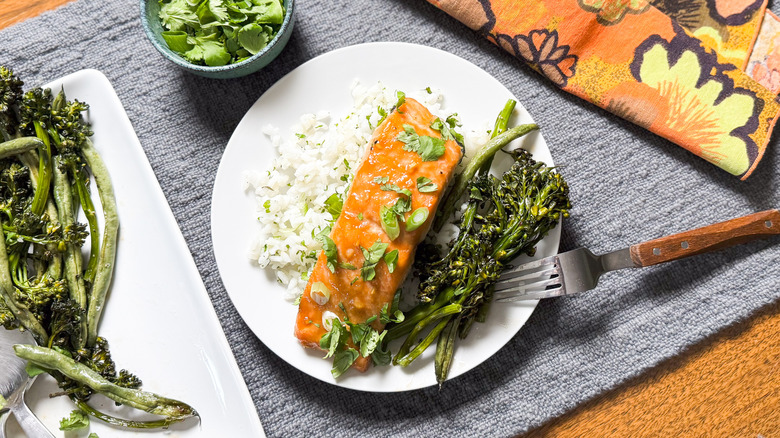
Ingredients
- ¼ cup white miso paste
- ¼ cup maple syrup
- ¼ cup mirin
- 2 tablespoons soy sauce
- 1 tablespoon sesame oil
- 1 large clove garlic, minced
- 1 tablespoon chopped fresh ginger
- 4 (6-ounce) skin-on salmon fillets
- 1 cup white rice
- 2 teaspoons sea salt, divided
- ½ cup chopped fresh cilantro, divided
- 1 bunch broccolini, tough stems trimmed
- 2 cups slender green beans, trimmed
- 2 tablespoons avocado oil
- ½ teaspoon freshly ground black pepper
- ¼ cup thinly sliced scallions
Directions
- In a bowl, mix together the miso, maple syrup, mirin, soy sauce, sesame oil, garlic, and ginger.
- Set aside 2 tablespoons of the miso maple marinade in a small bowl.
- Place the salmon fillets in a large ziplock bag and add the remaining marinade.
- Refrigerate the salmon for 30 minutes.
- While the salmon marinates, bring 2 cups water and 1 teaspoon sea salt to a boil.
- Add the rice, stir, and bring back to a simmer.
- Cover and cook for 15 minutes.
- Turn off the heat, fluff the rice, and stir in ¼ cup of the cilantro. Cover and set aside.
- Preheat the oven to 425 F.
- Line a baking sheet with parchment paper.
- Remove the salmon fillets from the marinade, shaking off the excess, and place on the prepared baking sheet, skin side down. Discard the marinade.
- Toss the broccolini and green beans with the avocado oil, remaining teaspoon of sea salt, and pepper in a large bowl.
- Arrange the vegetables around the salmon on the baking sheet.
- Bake the salmon and vegetables for 10 minutes, then drizzle the salmon with the remaining 2 tablespoons of marinade.
- Bake for an additional 5 minutes or until the salmon is opaque and the green beans are tender.
- Transfer the salmon and vegetables to a serving platter and garnish with the remaining cilantro and scallions.
- Serve the roasted miso maple salmon with the rice on the side.
What is miso paste and what are some other ways to use it?
Miso paste is a savory, umami-rich condiment made from fermented soybeans, salt, and koji (a grain-based fermentation agent). Although miso paste is found in thousands of variations in Japan and elsewhere, there are three typical classifications found in the United States: white, yellow, and red. The deeper the color of the miso, the more intense the flavor, due to a longer fermentation time. The white miso used in this recipe for salmon is the mildest variety and has a subtle sweet flavor that balances the saltiness. This type of miso is the basis for miso soup, dressings, sauces, or more delicately flavored preparations like miso garlic mashed potatoes. White miso can also work as a secret ingredient in sweet preparations like chocolate chip cookies or rice krispie treats.
Moving up the flavor scale, yellow miso has a bit longer fermentation time, uses more barley and less rice than white miso, and has a more pronounced earthy taste. Kinnaird says this type of miso is perfect for hearty soups, poultry marinades, or more intense condiments. Last, but certainly not least, red miso is fermented for 12 months or more and has the highest amount of soybean and a deep reddish-brown color. Red miso is best used with red or game meats, hearty stews, or in a rich glaze.
What is the best type of salmon to use for this recipe?
Choosing salmon for a recipe goes beyond picking a simple skin-on fillet. First, you should consider if you want to purchase wild-caught versus farmed fish. Pacific salmon includes Chinook, Sockeye, and Coho species. These are usually wild-caught in the open ocean using lines or nets. Yet, all of these species can also be farmed. Most Atlantic salmon on the American market is farmed, as it is a protected species. If a salmon is farmed, most grocery stores will label it as so.
Farmed salmon does potentially come with higher rates of toxicity, as these fish consume often undisclosed amounts of pesticides and antibiotics, and feed on unnatural pellet diets. The most sustainable salmon choices are wild and line-caught, and Kinnaird says she typically prefers the flavor and quality of these options. Regardless of which type of salmon you choose, always look to see that the flesh has a nice sheen, firm texture, and no overly fishy odor.
